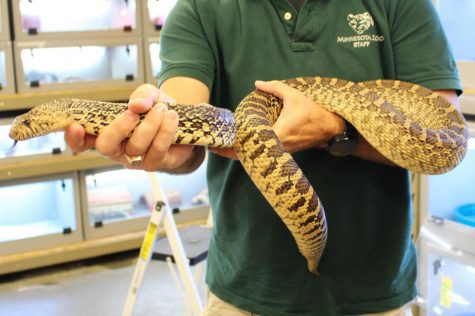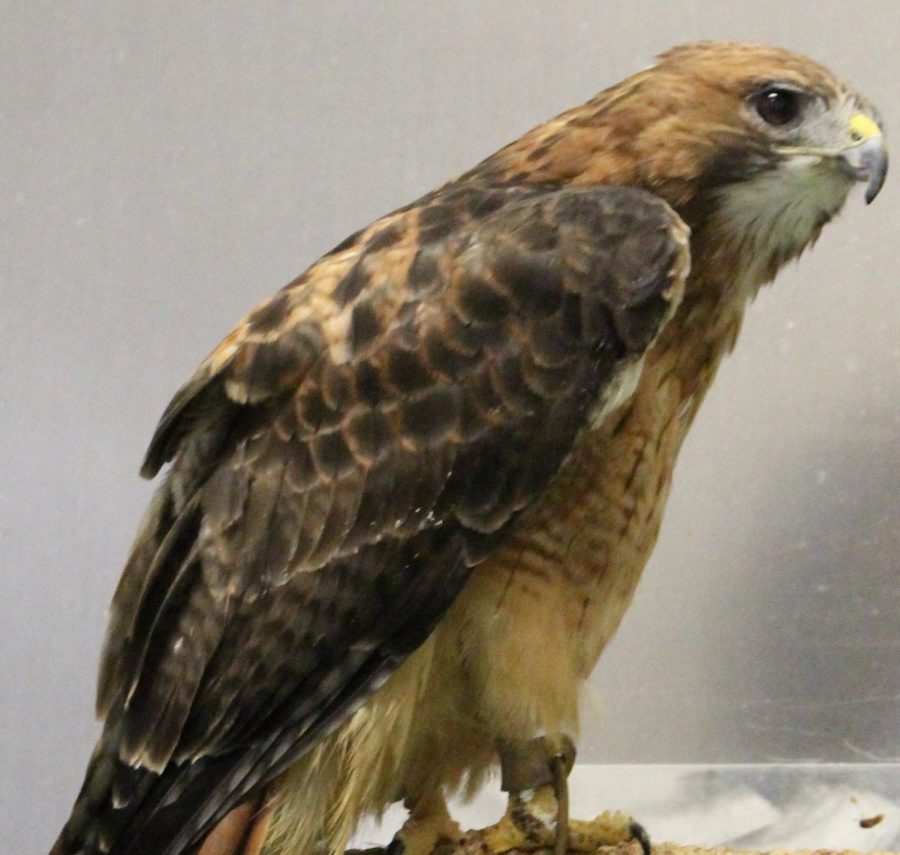It’s a jungle out there
CFHS student Teagan Strecker has a unique connection to the Minnesota Zoo
Glow in the dark scorpions, hawk money carriers, bunnies fluffier than cotton candy, all are just some of the unique and fun creatures found behind the scenes at Zoomobile. My mom, Carol Strecker, works at the Minnesota Zoo as the Director of Education. In the summer, we went to take pictures and gain some more engaging stories and information. I collected some interesting facts and photos about the Zoomobile, a branch of the Education Department that travels around the state so people can experience personal, upclose, educational encounters with live animals. Zoomobile allows the Zoo to reach more people around Minnesota.
The Zoomobile program delivers both onsite and outreach presentations. Onsite programs support zoo camps, birthday parties, daily animal demonstrations for Zoo visitors, picnics, and Zoo-wide events. The outreach program uses minivans to travel throughout Minnesota and deliver one to two hour demonstrations at various venues such as libraries, schools and hospitals. For example, in 2016, Zoomobile visited forty-six counties with seven full time staff and three vans. Zoomobile has around ninety animals in action, representing forty-four species of birds, reptiles, mammals, amphibians, and invertebrates.
Zoomobile animals are selectively chosen and trained to be “ambassador” animals, which means they participate in educational programing and presentations, and can be trusted to not only to be safe, but to leave a lasting impact on the audience as well. The name itself comes from the idea that they are serving as “ambassadors” for their species, helping to raise awareness about conservation towards their species and animals in general. Carol Strecker, the Director of Education for the Minnesota Zoo, explained what traits are considered in deciding whether or not an animal would make a good ambassador animal. The first factor is how trainable they are as some species or individuals are more easily trained than others. The second is how comfortable they are of being held for extended periods of time. This is also influenced by if the animal even can or needs to be held during a presentation, and how long they will typically be in a presentation. Also considered is how easy they are to transport, and how the weekly to daily transportation and handling may affect their health, as some animals need larger enclosures or have routine care that needs to happen at a specific time each day. Another factor taken into account is how comfortable the animal is around humans, and if it is an animal that will tolerate being touched by strangers. All of the birds and many of the other animals can’t be touched because of safety issues, but some animals can be touched by the public if a zookeeper is holding the animal, and a few can even be held by the public with the zookeeper watching. However, this is not common and is only done in specific situations as it could endanger the animal if done wrong. They also have to consider the overall behavior and habits of the animal. If they often show fear or act up and bite then not only is the animal not exhibiting the behavior they want, but it is clearly not comfortable around humans either. Finally, they must consider what emotion that animal would evoke out of a person. In order to be sure the experience will leave a lasting impact on the audience, the animal must evoke a noticeable or easily recognized emotion that positively affects both the person and the animal in the long run.
Ambassador animals are special, because they make it possible for Zoo guests to interact with animals beyond just watching from behind a fence, or a glass window. Keeping these animals happy and healthy whether they are training, serving in a presentation, traveling, or just resting at the Zoo, is especially important. To adhere to these needs, the animals are cared for on a regular basis. At any given time in the Zoomobile program area, there are at least two people to do all the cleaning, diet preparation, training, and caring that happens every day for the eighty to a hundred animals that live there.
Carol Strecker describes an important step taken to insure these animals’ well being. “Most of what has to go into their care on a daily basis involves their health. One of the most important steps to keeping them healthy is tracking their habits and everyday activities.” She explained that every individual Zoomobile animal has a number. That number is in a computer, and is how the staff keep track of all the information about that animal. Everytime it gets fed, weighed, given medicine, had it’s enclosure cleaned, etc., it all gets recorded in the computer. Also, since the regular travel and presentations can potentially cause stress, all the traveling hours and program hours are tracked and compared against the animals weight, eating habits, sleep patterns, and even poop patterns. Their regular habits and behaviors are recorded too. “Its similar to a medical file that you would have in a hospital.” Carol explained, “All of the information is checked on a regular basis, so if something changes, the staff can quickly detect if an animal is not feeling well or if its care needs to be altered slightly.” If it isn’t feeling well, the information on the computer should help the staff determine what’s wrong, and whether or not to call the vet. Also, the Zoomobile staff know the animals really well, so they can catch things that zookeepers who don’t normally work with the Zoomobile animals might not catch. The Zoomobile animals are closely monitored to the smallest behavioral change, all to make sure the animal is both healthy and happy.
Ambassador animals’ main job is to increase empathy for animals and awareness about conservation, but like any job one needs training to successfully fulfill the requirements. Ambassador animals are trained to exhibit their positive natural behaviors, so that their audience demonstrations and guest encounters will leave a positive impact on their audience. With the animal’s health in mind, trainers use positive reinforcement to associate natural behaviors with a cue, such as a hand movement or a sound. To start training, when the animal exhibits a desired natural behavior, it gets rewarded with a treat, but if it doesn’t, no negative reinforcement is used, it just simply doesn’t get rewarded. They repeat this many times until the animal understands the correlation between the treat and the behavior. They then introduce a command such as a sound or hand motion to signal to the animal when they want them to exhibit the behavior. When they do, they receive a treat. All of it is positive reinforcement, and all of it designed to make the animal feel comfortable doing it. Through the positive reinforcement, the animals learn what they are supposed to do, and do it happily, knowing they are going to get a reward. In turn, the audience gets to see a cool animal doing a unique behavior, all while learning the importance of conservation.
Zoomobile helps the Zoo to meet its mission to connect people, animals, and the natural world to save wildlife. As a state agency, the Minnesota Zoo strives to educate everyone in Minnesota, but they know many people are too far away to come to the Zoo. So, Zoomobile was born, and now, thanks to many years of hard work, Zoomobile has served many people, and many people now know the importance of conservation and the ways they can contribute, too.

